
The Dassenauch women and children gathering in the middle of the village to start a song and dance that we will join in on.
Ethiopia is home to some of the last tribes living traditional lifestyles in Africa. These tribes live in the Lower Omo Valley, a two or three day drive south from the capital of Ethiopia, close to the traditional lands of the Maasai tribe that we visited at the start of our trip in Kenya. The Maasai visit was well organized and welcoming; we learned a lot about the fascinating Maasai culture. We expected the Lower Omo Valley to be a similar experience, but it was much more raw and unstructured. These tribes are used to being visited by tourists on a daily basis, but they don’t speak English or Amharic, own phones, or have much understanding of modern living. Their ignorance stems from their remoteness, lack of education and language barriers. For each tribe, you must hire a local guide who grew up within the tribe but now lives in the closest town and speaks passable English. Our tour companies’ guide, Shasha, is from the capital Addis Ababa and speaks Amharic, but none of the tribal languages.

A drinking gourd.
When we would arrive at any particular village, we were assigned a guide at random en route to the tribal area. Because of this, the local guides were generally mediocre; they translated and told us a few facts about the tribe, but when we tried to ask questions they were unable to understand enough about our background to understand our question. They could understand our words, but we were somehow unable to get a meaningful answer to many of the questions that we asked. So, at the end of our visits we left with powerful impressions and only the information we observed or read in our guide book. The visits were generally awkward; most villagers seemed excited to see us, but some were indifferent or perhaps annoyed.

A Dorze house. They build their houses out of bamboo in the image of an elephant. Bamboo poles make the frame and construction ladders, the shells of the bamboo stems make tiles, and the false banana plant fiber makes string to bind the structure together. Inside the house it is very dark, lit only by candles, a fire, or maybe a single solar-powered light bulb.
Our favorite visit was to the Dorze (pronounced door-zee) people. The Dorze are considered a ‘people’ not a ‘tribe’ because they live a more modern lifestyle, using some solar panels and wearing modern clothing. The Dorze number around 54,000 and live in the green Gamo Highlands in tall houses of bamboo that are shaped to resemble an elephant. The house is partitioned into two sections: one for the animals to sleep at night, and one for the people to sleep and cook. Cooking in the house not only keeps the house warm in the cool mountain air, but also kills termites in all but the bottom of the house walls. In fact, they build their houses tall so that the house can shrink from termite damage for years without needing to be rebuilt.
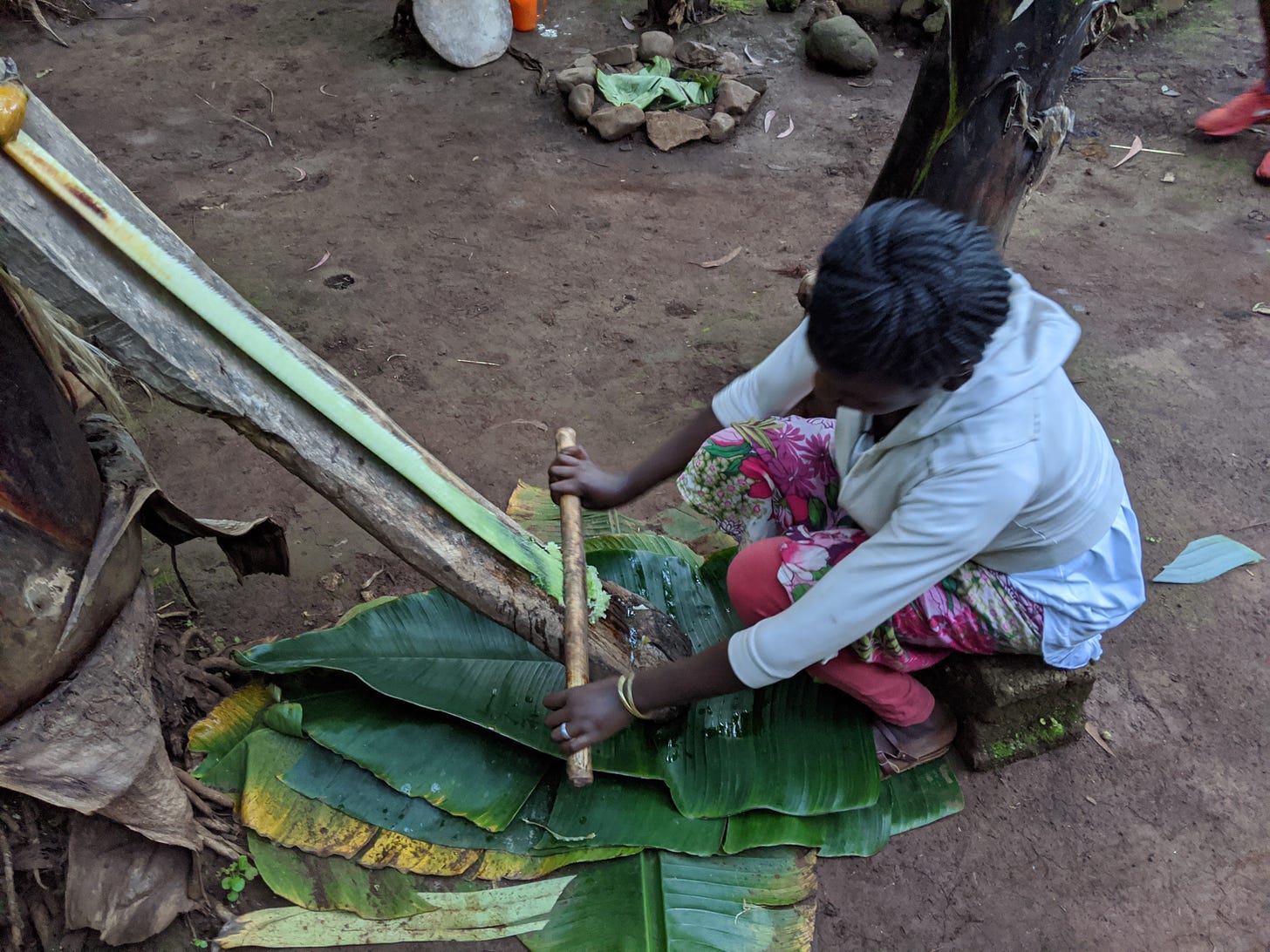
Our Dorze host showing us how she scrapes the pulp from the stem of the false banana plant.

The pulp is buried in false banana leaves and left to ferment for 3 months to 2 years. Then it can be reopened to supply dough for a flat bread called kocho.

The kocho patty cooks in banana leaf on a fire in the families’ false banana plant garden.
The false banana plant, called enzo, is critical to the Dorze lifestyle. Every family compound has a small garden with 5-10 mature false banana plants. The plant resembles a banana plant but does not produce bananas. The false banana plant’s stem pulp is used to make their staple food ‘kocho’, the leaves are used as umbrellas, food containers and animal feed, and the stem fiber is used for rope and towels. Kocho pulp is obtained by scraping pulp from a strip of stem and chopping it, in order to tenderize the pulp. The pulp is then wrapped in a banana leaf and buried underground for 3 months - 2 years to ferment. Three times a day, Dorze women will dig up a fermented pulp stash and remove some for a meal. They knead and flatten it into a large tortilla, and then fry it in a banana leaf with no oil to get kocho. The kocho is eaten with coffee tea in the morning, honey and spicey garlic paste at lunch, and wild spinach at night. Like most traditional peoples, meat is eaten only on special occasions since it requires the sacrifice of one of their precious animals.

Ryan and I tried the kocho with the spicy garlic paste and raw honey (with bees and wax crushed up inside it!). It was delicious!! Freshly made kocho has the texture of a thick tortilla, and the faint flavor of Parmesan cheese. After eating the kocho, we took three shots with some of the men of the tribe. This tradition is performed in order to help kill bacteria and keep us warm. We didn’t get sick afterward, so I guess it worked!
The word Dorze means weaver, and this is the primary occupation of most of the men in the tribe. They weave blankets for warmth and business. Our guide informed us that to be a desirable Dorze man, you should be able to weave, farm and dance with your hips well. The women should be good at making kocho, spinning cotton and also dancing with their hips.

A Konso man showing us how the weaver works.

An older Konso woman spinning cotton by hand.
At the end of our tribe visits, we met another people similar to the Dorze called the Konso. The Konso are also known for their weaving and live in a permanent village near a major road. They eat mostly sorghum, soya beans and a spinach-like plant called moringa. They are famous for their tiered hillside agriculture, and their village sits atop a steep hill with only walking footpaths. As a rite of passage into manhood, the Konso do not practice adolescent circumcision like the Maasai, instead the boys must lift a large boulder above their head and drop it behind their backs in order to prove that they are men. Ryan and I tried to lift the boulder; it was VERY heavy. We were able to lift it, but were too scared to try to lift it above our heads. This boulder ceremony takes place in front of a cluster of generation poles. Every 18 years, the village adds a large tree trunk to the cluster of generation poles, and tribe leadership symbolically passes from the oldest generation to the current young adults. This cluster also marks the age of the village. We saw at least 6 generation poles in this cluster, making this Konso village over 100 years old.

The generation pole, and at its base the large boulders that Konso boys must lift above their heads in order to become men.
After the Dorze visit, we spent three more days visiting the remote tribes of the Lower Omo Valley. Most of the people living here have never seen a city. The government mostly ignores them, and they ignore the government, although more effort is being made to get the tribal children to attend school. The tribes live in harmony with the environment. Other than some tourist-donated t-shirts, a few jelly shoes, and jerry cans, they have no manufactured items whatsoever. They build their houses out of local grasses and wear animal skins or blankets woven from local cotton. Everything they eat and drink comes from their farm or livestock. They eat and drink out of hollow calabash gourds and cook on small grass/twig fires. They grind their own grain between two flat stones. They can seek medical attention from a small clinic in the closest towns, but mostly they rely on local remedies. When they travel, they walk. They carry their water from the nearby stream in jerry cans. When they move, they pick up their house or build a new one in a couple days. They go to the market in the nearby small town every week to sell an animal and buy the things they do not produce like oil, sugar, and coffee.

Inside a Dassenauch hut. Jerry cans and water bottles are the only manufactured items.
Our first tribe visit was to the Bana, a tribe of about 10,000 people. The Bana women wear their hair in distinctive small dreadlocks formed by rubbing clay and butter into the hair. The Bana mostly eat milk, honey and porridge/mash/injera bread made from sorghum, corn, and teff (the grain used to make injera).
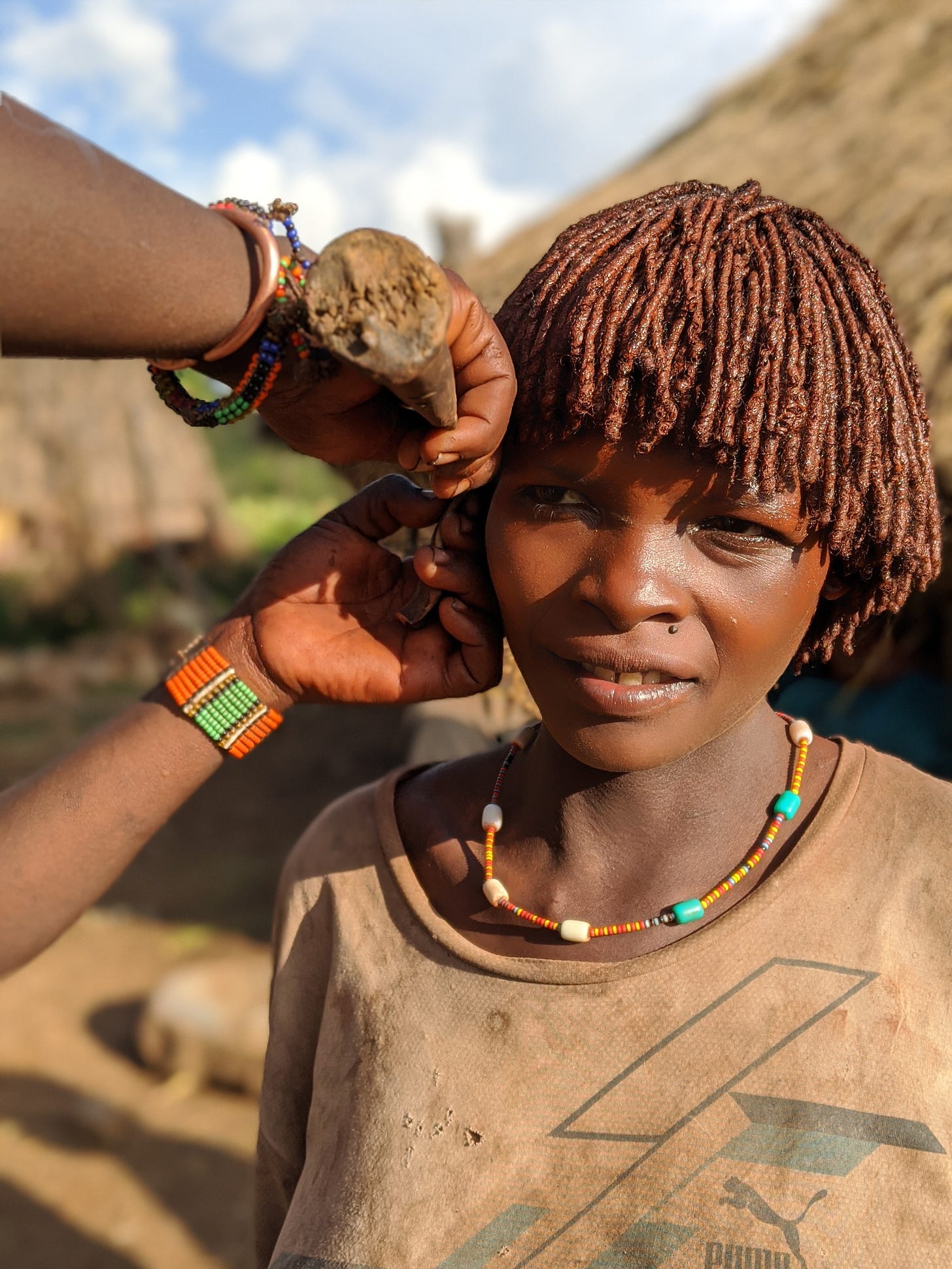
A Bana woman getting a haircut with a knife and a piece of leather.
We were welcomed to the Bana village by a matriarch named Jinka. She was topless other than a loop of the animal skin around her neck decorated with cowry shells and beads. Around her waist, she wore a heavily beaded colorful skirt. She always wears her animal skin necklace when she is cooking as a sign of respect to her husband because it is her wedding outfit.

Jinka and I in her hut. She had me wear her animal skin wedding necklace.
Jinka invited us into a hut which had been recently built for a potential second wife. The Bana, like most African tribes, are polygamous. A man can have many wives as long as he can afford the bride price for each. Every wife gets her own hut in a family compound, and Jinka’s husband was preparing to take a second wife.
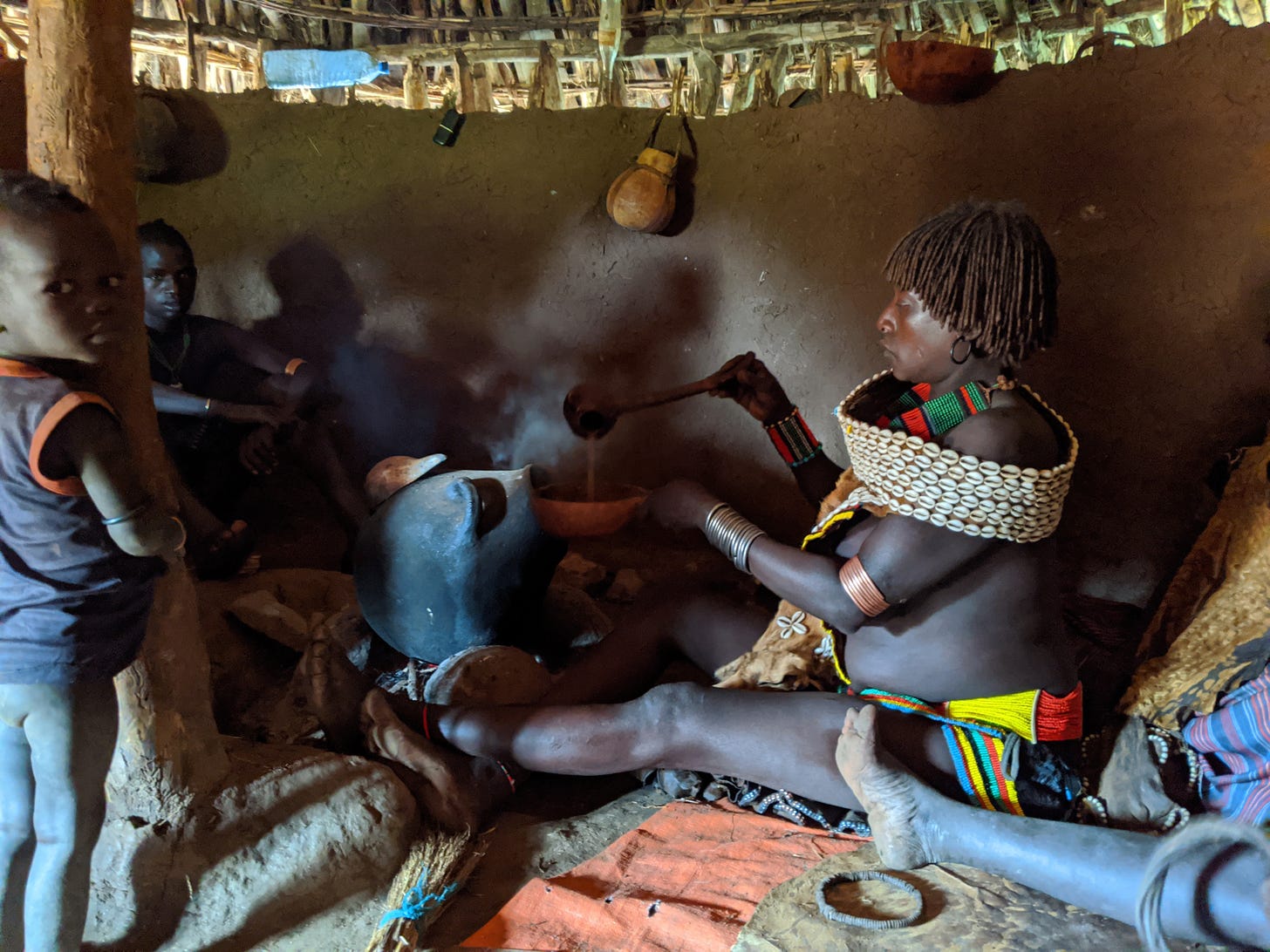
Jinka preparing coffee tea in a large gourd inside a hut that has been newly built for a potential second wife. Coffee tea is made from the leaves of the coffee plant. The little boy on the left is her son whom she named 'Chicken'.
Inside the hut, six village members and our local guide sat and chatted in their local language. Jinka was boiling coffee tea in a large gourd inside the hut and she began distributing it in empty calabashes. Coffee tea is a tea made from the leaves of the coffee plant, it’s much more common than regular coffee in the Lower Omo Valley. We were all given a large ring that looked like a baby toy; on this ring we could rest our calabashes. When I got my calabash of coffee tea, I waited for it to cool and then took the smallest sip I could manage. This village is nowhere near plumbing or sanitization of any kind, and we were drinking boiled river water out of a gourd that had been used many times and never washed. Ryan happily drank most of his gourd, but neither of us got sick. During the visit, our local guide translated a few comments that Jinka made to us. In addition to asking our names, ages and where we were from, Jinka wondered when she would get to visit our country. Jinka is around 28/29. She doesn’t know her exact age like many traditional Africans, because it is not common to keep track. She has 8 kids! We met her tiniest baby boy; he was named “chicken” because he looks like a chicken.

The Bana village gathered with us for a group picture.
After the coffee tea, we moved outside the hut and sang and danced and took photos. Jinka was confused by the shape of my chest under my shirt, because I was wearing a bra. She reached out and squeezed my chest and then looked into my shirt collar to see the bra! It was surprising and funny. On the drive away from the village, our company guide Shasha told us that on one visit, Jinka told the woman visitor that she should also be shirtless for the photos, and the tourist ladies took topless photos with Jinka. She did not make that request of me.

Ryan crawling into the tiny entrances to the Mursi huts.
The next tribe we visited was the Mursi, also numbering about 10,000 people. The Mursi live in very small grass huts with tiny entrances. The small entrances preserve privacy and prevent enemies from entering the hut easily. They were so small that you had to crawl on hands and knees and Ryan and I almost got stuck. The small size also causes the cooking smoke to fill the entire hut and sting lungs and eyes.

A Mursi woman wearing her lip plate.
The entrances are more reasonably sized for the Mursi people, who are shockingly long and slender people. Their body types reminded me of the slender Maasai warriors. The Mursi are famous worldwide for being one of the last tribes to still practice lip gauging. After marriage, the women will gauge their lips for a giant lip plate if the husband finds it desirable. The practice is slowly losing popularity, but tourist interest drives some groups to continue it. The lip plate is only worn for special occasions, for obvious practical reasons. It is also common for women to remove all 4 of their bottom teeth, and for men to remove 2 of their bottom teeth. The origins of these practices are unknown.

Mursi women without the lip plates. The lower lip hangs loose over the chin, or constricts to look somewhat normal over the bottom teeth.

Scarification and ear gauging is practiced for beauty by the Mursi.
When we visited, there were only women in the village as the men are usually busy with the animal herds during the day. It’s apparently also strategic to avoid the men as the Mursi are renown for their fierce characters. Women do almost all the work for the village. They fetch water from 10km away, they build the houses, farm, hand grind the grain and cook. They mostly eat milk, blood of the cow, and honey like the Maasai. They also eat sorghum/corn porridge or popcorn.

Mursi owned cows being herded down the road to pasture. The Mursi turn their cattle's horns inward for identification. Wealth and status among the Mursi is solely based on cattle ownership.
The Mursi are also polygamous and every man will have 2-8 wives. I tried to ask if this lead to a shortage of wives for some men, but the guide didn’t understand why I would think that. “There are always plenty of women,” he said. I assume more men must die fighting? The Mursi man must pay 36-40 cows and a kalishnikov to the bride’s family in order to marry. Like the Maasai, cows are very important to the Mursi. Wealth is measured in the number of cattle owned, and it is common for them to name themselves after the markings of their favorite cow.

Failing at grinding corn in the hut of a Mursi woman.
Our visit to the Mursi was one of the most awkward. Our guide didn’t really translate much, and it was raining so we were squeezed in a hut entertaining the women with photos. They loved having their photo taken and looking at the pictures and videos of themselves and other tribes. Then, the guide brought us to a hut where a woman was grinding grain and cooking. The hut was horribly smoky, and the guide wanted me to try grinding the grain. However, the woman didn’t seem excited to let me fumble with her grain and when I did try, I did it wrong and the woman got annoyed. After the rain stopped, I was holding my rain jacket while we hung out outside the huts. Some of the women were trying to grab my jacket; I thought they wanted to look at it and so I let one of them take it. She put it on and was very pleased and wore it for the rest of our visit. When it was time to go, she did not want to give it back. It dawned on me that she thought I gave it to her, and I could see our local guide was stressed as he tried to get her to give it back. After he asked her to return it, she said something and then ran into her hut. I still had months of my trip left, and needed that rain jacket so I couldn’t let her keep it. I realized I was probably not going to get it back without leaving her something, so I went in the van and grabbed a shirt that I could part with. She accepted the trade even though the shirt was way less cool than my rain jacket. 😬
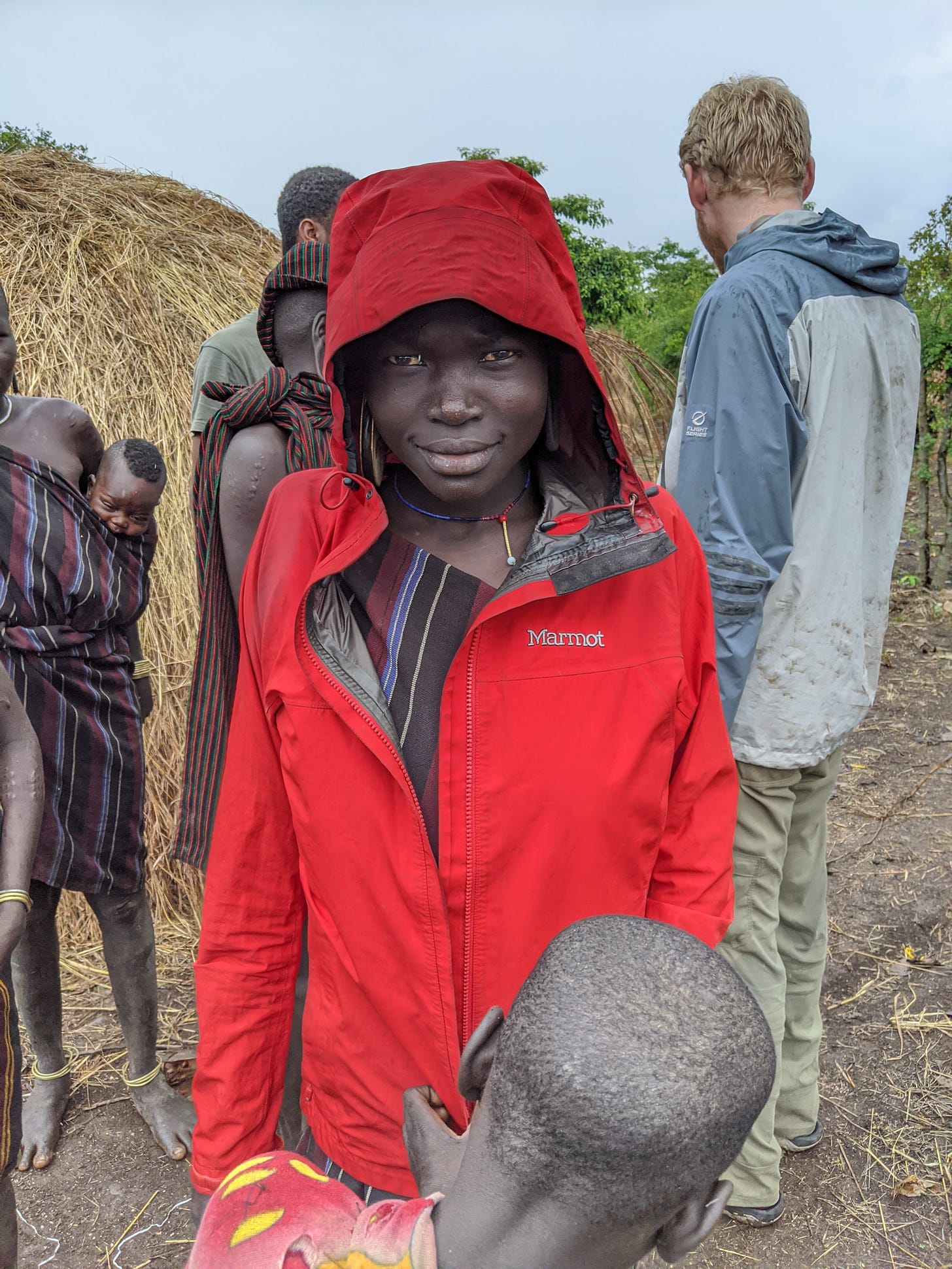
The girl who wanted to see my jacket… and never give it back. 🤪
The Hamer tribe resembled the Bana in hairstyle. The Hamer village that we visited was cleaner, more spacious and generally more pleasant than the village space of the Bana and Mursi families that we visited. The Hamer are famous for their coming of age traditions. For a boy to become a man and be eligible for marriage, he must participate in a bull jumping ceremony. 8-20 cows and oxen are lined up, and the boy must run across the backs of all of them four times in a row without falling. Before and during the ceremony, the women relatives of the boy allow themselves to be whipped to show their love for their relative and strength. Although tourists sometimes attend these ceremonies, Ryan and I did not see one.

The tidy Hamer village.
We visited the Hamer village in the early evening. This meant that the men and animals were home from grazing, and the village was cacophonous with the bleats of dozens of baby goats, shouting boys, and groans of cattle. After a day grazing in the surrounding countryside, the animals were running around enjoying the last few hours of freedom before being put in protective enclosures called croixs for the night. The evening chaos and a large group of French tourists made our visit lack cohesion, and we walked away not really having met any tribe members.

A Hamer woman and her child. She has a copper necklace that marks her status as a first wife.
The last remote tribe we visited were the Dassenauch. The Dassenauch village had been displaced in recent times due to floods and NGO’s had provided corrugated iron sheet metal to them to help them build shelters. Because of this, their huts are made from grass and corrugated iron instead of just grass like the other tribes. The Dassenauch practice flood retreat cultivation on the Omo Delta, meaning that they grow crops on the fertile ground left behind as the river recedes in the dry season. Like many of these remote tribes, their traditional lifestyles are threatened by dams and relocation programs that make flood retreat cultivation impossible.
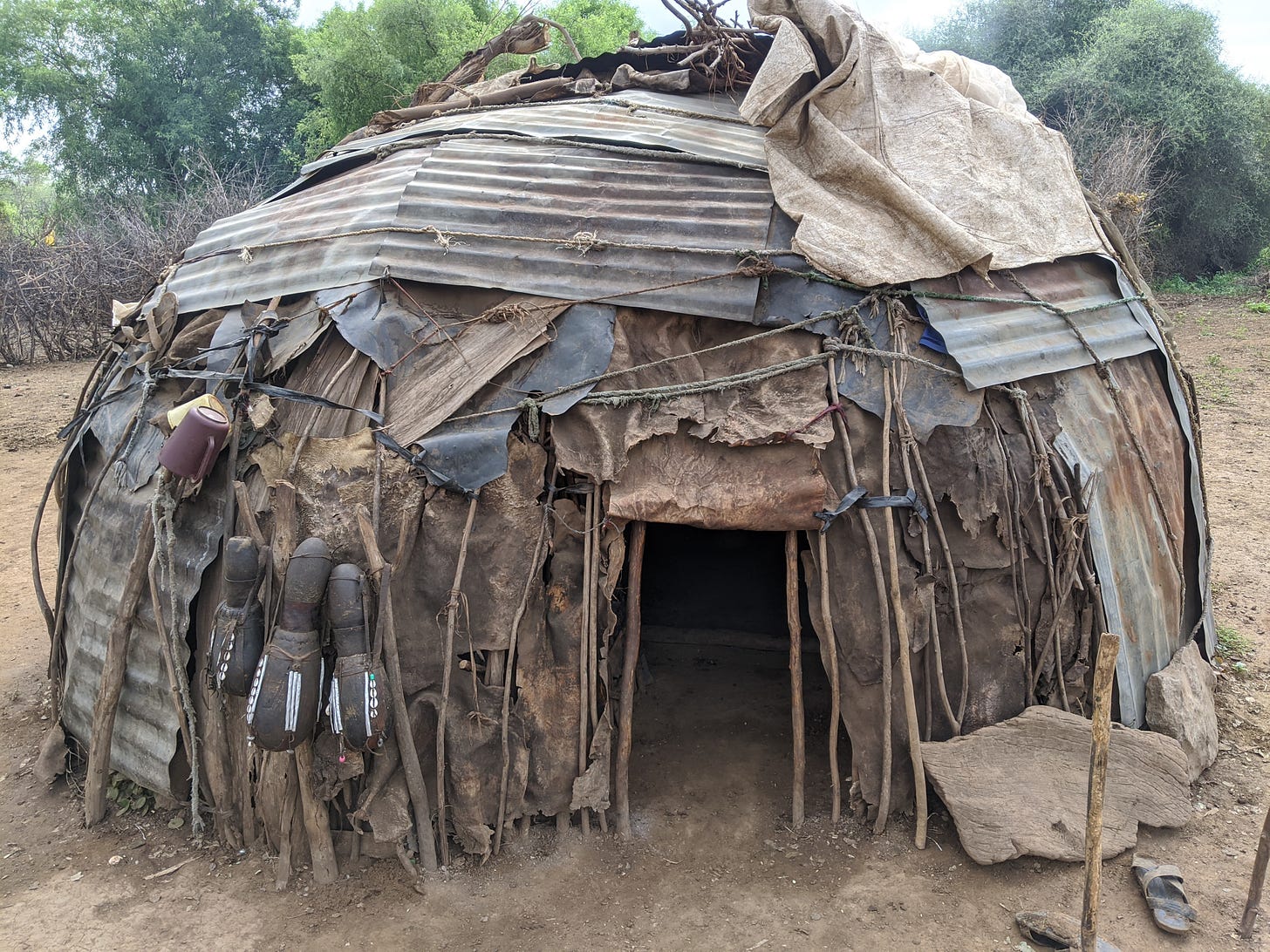
A Dassenauch hut made partially from corrugated iron. The government gave the Dassenauch corregated iron to rebuild huts when large floods displaced them.
The Dassenauch are polygamous and live in villages of a few families. Like the Maasai in Kenya, they practice teenage circumcision as a coming of age ritual for both boys and girls. They eat fried corn with milk, and also fish and hunt crocodile on the delta.

A Dassenauch woman making corn porridge.
It seems like it is only a matter of time until these tribes conform to the western lifestyle. Already these people have been pushed from their traditional lands to smaller, less fertile regions. Their constant contact with tourists and the government’s efforts toward education is sure to inspire more young people to move to town and pursue ‘easier’ lives. After meeting these groups, I felt a sad sense of loss for the collective knowledge of how to live in harmony with nature. How many people could survive in North America without any modern item? In the rush to have nice things and live a better life, we work more and fill the planet with trash! At the same time, the current population of California would never be able to support itself on the natural resources nearby without demolishing forests and giving up centralized city dwelling entirely. The tribes of the Omo Valley have inspired me to make greater efforts to live a lifestyle that doesn’t produce trash and pollution. They also further strengthened my belief that community, rituals and tradition are deeply important to the mental health and stability of communities. How can we make traditions and rituals for our communities that reflect our values and strengthen our identities?

A street in the Dorze village in the cool Gamo Highlands.


